

How to Write a Recount Text (And Improve your Writing Skills)
WHAT IS A RECOUNT TEXT?

The recount text type retells an experience or an event that happened in the past. The purpose of a recount is to inform, entertain, and/or evaluate.
A recount can focus on a specific section of an event or retell the entire story. The events in a recount are usually related to the reader in chronological order; That is, in the order they happened.
Recounts are an excellent genre for emergent writers to cut their teeth on. Written mainly in the past tense, recounts offer younger student-writers the opportunity to tell a story in writing without placing cumbersome demands on their creative abilities to construct a well-structured storyline. To avoid the necessity for any research, personal recounts are often the best place for beginners to start. All they’ll need for their plot is a half-decent memory!
A COMPLETE UNIT ON TEACHING RECOUNT WRITING

MASTER RECOUNT WRITING with this complete EDITABLE UNIT that ensures your students learn how to retell events with accuracy and energy. covering PERSONAL, FACTUAL, LITERARY and HISTORICAL RECOUNTS.
Teach your students to write AMAZING RECOUNTS in various styles with this COMPLETE 78 PAGE UNIT . No preparation is required.
WHAT ARE THE FIVE TYPES OF RECOUNT?
There are many different styles of recounting. Let’s take a look at the five main types before studying the recount text structure and features.
PERSONAL RECOUNT : A Personal Recount text retells an activity in which the writer has been personally involved. Personal recounts often build an intimate relationship between the writer and the reader. Some common types of personal recounts include anecdotes, diary & journal entries, personal letters, etc. While there are some differences, a personal narrative has much in common with a personal recount.

PROCEDURAL RECOUNT: A Procedural Recount records the steps in an investigation or experiment, thereby providing the basis for reported results or findings. A procedural recount records events such as a science experiment or cooking. Procedural recounts present the events chronologically (in the order in which they happened). The purpose of procedural recounts is to inform the audience. They differ somewhat from a traditional procedural text .
FACTUAL / NEWSPAPER RECOUNT / HISTORICAL RECOUNT : Factual Recounts report the particulars of an incident by reconstructing factual information, e.g. police reconstruction of an accident, historical recount, biographical and autobiographical recounts. A factual recount is an objective recount of an actual event by someone not personally involved in the situation. Its purpose is either to inform, entertain or both.

LITERARY RECOUNT: A Literary Recount retells a series of events for the purpose of entertainment. A literary recount is like a factual recount in many regards. Both provide details about what happened, including who was involved, when and where the event occurred, and what may have resulted. A literary recount can be about real or fictional events and characters.
IMAGINATIVE RECOUNT : Applies factual knowledge to an imaginary role to interpret and recount events, e.g. A Day in the Life of a German soldier, How I manned the first mission to the moon. An imaginative recount is retelling events, usually in the first person. This style of recount allows for embellishment beyond facts and events- perfect for creative writing.
STRUCTURE AND FEATURES OF A RECOUNT
Recount structure.
ORIENTATION Explain the who, what, when, and where of the experience in your introduction.
FOCUS Only significant events are included.
CHRONOLOGY Events are described in the sequence in which they occurred.
ORGANIZATION Relevant information is grouped in paragraphs.
INSIGHT Include personal comments, opinions or interpretations of the recounted experience or event.
RECOUNT FEATURES
TENSE First and third person are used most frequently, and recall is always written in the past tense. Present tense can be used for analysis and opinion.
NOUNS Use proper nouns to refer to specific people, places, times and events.
VOICE Both active and passive voice is used in recounts.
CONNECTIVES Use conjunctions and connectives to link events and indicate time sequence.
HOW TO WRITE A RECOUNT
POINTS TO CONSIDER BEFORE WRITING :
Writing a recount text in English is a deeply reflective process. As such, students will want to spend most of their writing time organizing the events, refining the details, and fine-tuning the language. Here are some questions for students to consider before beginning the writing process .
- What are you going to tell your audience? What are you recounting?
- What information will the audience need early in the text?
- What are the important events or parts of the recount you want to describe? In what order will they occur?
- How will you let your readers know the order of events? What language will you use to link the events?
- What other information may it be helpful to include?
- How will you conclude your recount?

Students must recount the who , what , when , and where as the bare minimum. To help them organize their thoughts, encourage the use of graphic organizers and mind maps.
At this point, students should consider some of the questions their audience might ask while reading the recount. For example:
- What occurred?
- Where did it take place?
- When did it occur?
- Who were the main characters/people involved?
- Why did certain things happen?
- How did things happen?
- What were some of the reactions to the events that happened?
- What are the concluding thoughts or ideas?
HOW TO STRUCTURE A RECOUNT IN 5 PARAGRAPHS

In terms of structure, the 5-paragraph/hamburger essay framework is perfect for the beginning writer.
This template suits most nonfiction writing genres and lays out a composition with one introductory paragraph, followed by three body paragraphs and one concluding paragraph. Check out our comprehensive article here to learn more about this effective format.
When used in the context of writing a recount, the 5-paragraph essay will look something like this:
The Orientation: Paragraph 1
In the introductory paragraph, the student will establish the setting and introduce the characters and the topic of the recount.
The Events: Paragraphs 2-4
Using past tense verbs, the student will relate the events in chronological order in the body paragraphs.
The Conclusion: Paragraph 5
In the final paragraph of their recount, the students should typically make some sort of evaluative comment on what they think or how they feel about the events they have just related.
The 5-paragraph essay format is very flexible, as students can easily alter the number of body paragraphs according to their abilities and the complexity of the events they recount.
THE 5 PILLARS OF WRITING A RECOUNT TEXT?
For beginning writers, graphic organizers are extremely helpful tools to assist during the planning process. These can be built around the 5-paragraph essay structure as described above.
Another helpful planning tool to help students plan their recounts is employing The Five Pillars of a Recount .
Essentially, the five pillars comprise five questions students must answer in their recount. These are

- Who? Who are the main characters?
- When? When did the events take place?
- Where? Where did the events happen?
- What? What happened?
- Why? Why do these events matter?
The student will have a basic outline for writing their recount by answering each of these questions.
While the who , the when , and the where are usually addressed in the orientation or introductory paragraph, the what will be taken care of in the body paragraphs, with the why most often providing the focus for the concluding paragraph.
TIPS FOR WRITING A GREAT RECOUNT TEXT
- Keep the title simple to summarise the text’s central element, such as “ A trip to the Zoo.”
- Set the scene for the audience in terms of characters, setting and context. We refer to this as our orientation, and it will provide the reader with all the essential ingredients of the recount in the introduction by addressing the who, what, when and where.
- Keep everything in chronological order in a recount and use a variety of time transitional terms and phrases to keep your audience engaged throughout.
- Use a range of adjectives; try and avoid “And then, and then, and then.”
- Each new section will require a new paragraph. Be sure to check out our Every new section will require a new paragraph. Be sure to check out our own complete guide to writing perfect paragraphs here.
- Use the correct language and terms relevant to your recount. Consider your audience and the language they will connect with.
- If you are writing from a specific point of view , use the relevant language to match the perspective. Most commonly, in a recount, you will be recounting in the first person.
- Recounts are always written in the past tense, so be conscious of staying in this tense throughout. Everything has already happened, so ensure your vocabulary reflects this.
- The challenge in writing a good recount is to provide the audience with the story as it happened but to leave out incidental and dull information.
- Ensure you also clearly understand your audience, as this will significantly impact the language you use.

Tools & Resources
Use your students’ resources and tools below to improve their writing skills through proven teaching strategies.
RECOUNT TEXT GRAPHIC ORGANIZER

RECOUNT WRITING PROMPTS AND TOPICS
Often, the topic of the recount will suggest itself in the form of a title. Recounts are great for forging cross-curricular links with other subjects. For example, you may want your students to write a historical recount on a topic they covered in social studies or create a procedural recount on an experiment they completed in science.
Generally, a recount’s focus is summed up in the title. For personal recounts, providing students with a title as a prompt is a great way to get the ball rolling without being too prescriptive, as it will still be up to the student to select the specific events they write about.
Here are a few ideas for titles for personal recounts:
- My Most Magical Moment Ever
- A Moment I Will Never Forget
- A Moment I Will Always Regret
- A Trip with My Best Friend
- My Favorite Memory
- The Biggest Surprise of My Life
- My Proudest Achievement
You’ll find more recount writing prompts for students below.

Recount Writing Example (Student Writing Samples)
Below is an annotated recount text example and student samples. Click on the image to enlarge and explore them in greater detail. Please take a moment to both read the different styles of recounting text in detail and also the teacher and student guides which highlight some of the critical elements of a recount to consider before writing.
Please understand these student writing samples are not intended to be perfect examples for each age or grade level but a piece of writing for students and teachers to explore together to critically analyze to improve student writing skills and deepen their understanding of recount writing.
We would recommend reading the example either a year above or below, as well as the grade you are currently working with, to gain a broader appreciation of this text type .
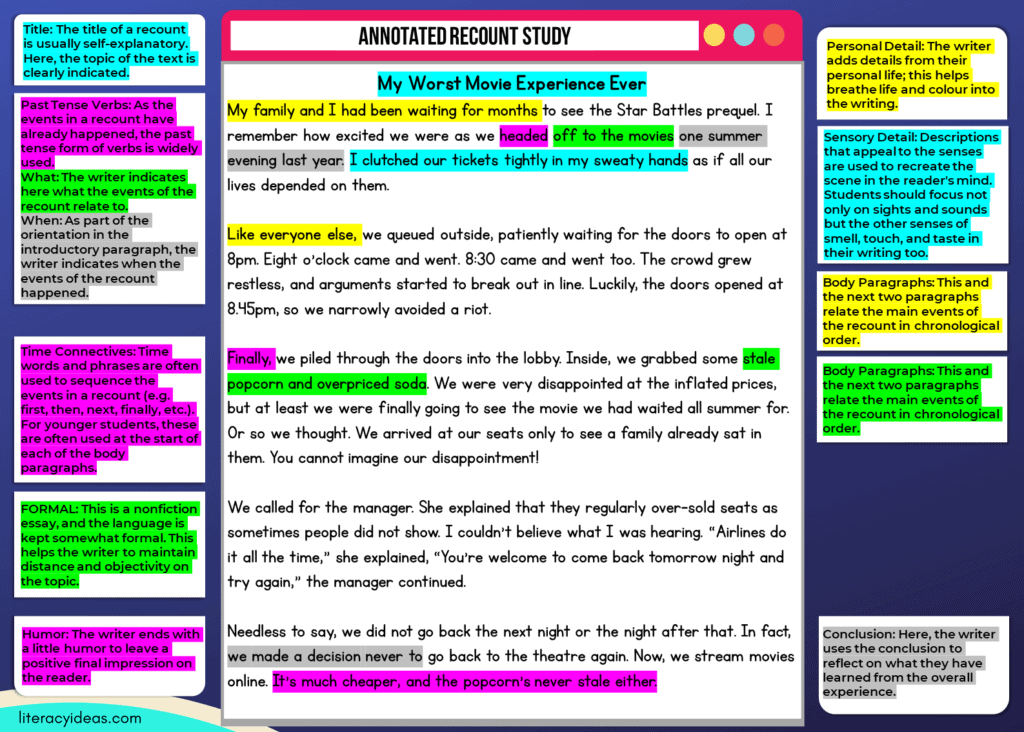
RECOUNT TEACHING RESOURCES
Easy recount writing activities for students.
ACTIVITY ONE: A SHARED VISUAL RECOUNT
Provide an image of a significant event all students could recount as a group. For example, this could be a school camp, the Olympic games, or a photo of a significant event within your community. Get students to work through the Who ? When ? Where ? What ? and Why ?
Once you have established these, students can start to place things in chronological order and prioritize what will be included in their recount draft.
At this point, get your students to collaborate on a recount of this shared event. You can use these as a starting point for comparison and analysis before students write their individual recounts.
ACTIVITY TWO: BUDDING JOURNALIST RECOUNTS
First, find a suitable video or a newspaper article. Set your students the task of taking notes on the KEY information. Make it clear to your students that they are writing a BRIEF newspaper article to share information with others and that personal opinions are not required for this task. The aim is to provide the audience with enough information to make their own opinions and inferences .
Let your students read or watch the article or video a maximum of twice. Notes should be brief. They are not trying to recreate the entire script or article.
When they have finished, check the chronology of their recounts. How successful were they in recounting the events in order?
ACTIVITY THREE: PAIRED FLOWCHARTS
When your students have created their own individual recounts, get them to share them with a partner. During this time, the reader will develop a flowchart of what happened and, if appropriate, be able to explain an action/reaction process, such as “You ate so much cake at your party that later that night, you got sick.”
By completing this conferencing process, students will hear first-hand if their recount makes sense to others.
RECOUNT WRITING CHECKLIST BUNDLE

RECOUNT WRITING VIDEO TUTORIALS

MORE GREAT RECOUNT WRITING ARTICLES

How to Write a Historical Recount Text

5 Easy Recount Writing Lesson Plans students love.

15 Awesome Recount & Personal Narrative Topics
- PRO Courses Guides New Tech Help Pro Expert Videos About wikiHow Pro Upgrade Sign In
- EDIT Edit this Article
- EXPLORE Tech Help Pro About Us Random Article Quizzes Request a New Article Community Dashboard This Or That Game Popular Categories Arts and Entertainment Artwork Books Movies Computers and Electronics Computers Phone Skills Technology Hacks Health Men's Health Mental Health Women's Health Relationships Dating Love Relationship Issues Hobbies and Crafts Crafts Drawing Games Education & Communication Communication Skills Personal Development Studying Personal Care and Style Fashion Hair Care Personal Hygiene Youth Personal Care School Stuff Dating All Categories Arts and Entertainment Finance and Business Home and Garden Relationship Quizzes Cars & Other Vehicles Food and Entertaining Personal Care and Style Sports and Fitness Computers and Electronics Health Pets and Animals Travel Education & Communication Hobbies and Crafts Philosophy and Religion Work World Family Life Holidays and Traditions Relationships Youth
- Browse Articles
- Learn Something New
- Quizzes Hot
- This Or That Game New
- Train Your Brain
- Explore More
- Support wikiHow
- About wikiHow
- Log in / Sign up
- Education and Communications
- Autobiographies
How to Write a Personal Recount
Last Updated: January 17, 2024 Fact Checked
This article was reviewed by Gerald Posner . Gerald Posner is an Author & Journalist based in Miami, Florida. With over 35 years of experience, he specializes in investigative journalism, nonfiction books, and editorials. He holds a law degree from UC College of the Law, San Francisco, and a BA in Political Science from the University of California-Berkeley. He’s the author of thirteen books, including several New York Times bestsellers, the winner of the Florida Book Award for General Nonfiction, and has been a finalist for the Pulitzer Prize in History. He was also shortlisted for the Best Business Book of 2020 by the Society for Advancing Business Editing and Writing. This article has been fact-checked, ensuring the accuracy of any cited facts and confirming the authority of its sources. This article has been viewed 127,187 times.
Writing a personal recount requires you to retell an activity or event that happened in your own life. You must structure your story in a way that makes sense while using language that matches the same purpose.
Considerations

- The first thing you need to understand is the writing prompt itself. If your teacher asks you to write about a favorite holiday memory, your recount needs to describe something that happened during a holiday. It should not describe a favorite memory that happened in school, after class on a normal school day, or during a normal weekend.
- Pay attention to requirements concerning length, as well. Your teacher may tell you how many words, pages, or paragraphs your recount needs to be. If these instructions are not included and you aren't sure about how long the piece must be, consider asking your teacher directly.

- Most recounts are meant to inform, entertain, or do some combination of the two. Personal recounts are generally written for entertainment, but if your teacher asks you to describe an event he or she was not present for—like what happened during your last sports game or during a time when a substitute teacher led class—you also need to make sure that you provide plenty of accurate information about that event.

- For classroom purposes, your recount will usually be written for either your teacher or your peers. Your teacher will want to see that you followed the instructions he or she provided. Your classmates will usually want to be entertained with a story they can enjoy or relate to.

- For example, if you need or want to write a personal recount about a fun summer memory, you probably shouldn't write about your best friend moving away. As a sad memory, describing the loss of your friend won't create the “fun” mood your recount is supposed to have.

- Choose something simple. For instance, a recount about your favorite pet might be titled, “My Favorite Pet.”

- Identify the participants. Even though a personal recount must retell a story from your own life, other people will probably be involved in your story, too. Mentioning these individuals early on will prevent the reader from being surprised or confused later.
- Explain when the activity happened and where it happened, as well. These details are crucial if you want your readers to understand the events of your story.
- For example, if you choose to write about a beach vacation spent with your family, consider starting with something like, “I spent the first week of July with my mother, father, sister, Uncle Eric, and Aunt Lydia. We stayed at a hotel on the beach.”

- For instance, if school was canceled for the day because of a major blizzard, you should mention the blizzard first, followed by the discovery that school was canceled. Write about what you did with your day off only after explaining why you had that day off.

- As a general rule, only describe events that the reader would not be able to predict. When writing a personal recount about your weekend, you could describe the games you played, the people you met with, and any special treats you may have enjoyed. You do not need to explain that you went to sleep each night or ate breakfast each morning, however, since those are things your teacher expects you to do every weekend.

- For personal recounts that cover an extended period of time, each paragraph might describe one easily separated portion of that time. A recount about your weekend might include one paragraph for Friday evening, one paragraph for Saturday, and one paragraph for Sunday. A recount about your summer might include one paragraph for May, one paragraph for June, one paragraph for July, and one paragraph for August.

- This is especially important when you are writing a personal recount about someone or something important. Personal recounts about your favorite pet should include a description of how your pet looks. Personal recounts about your grandparents should include descriptions of how your grandparents look and sound.

- Consider including a personal opinion about what happened. For instance, you might say conclude a personal recount about your Christmas with a statement like, “This past Christmas was very fun.”
- You may also need to conclude by describing the outcome of the activity. If you are telling a recount about your visit to the doctor, end with an explanation of what your doctor told you or what medicine he or she gave you. [3] X Research source

- For a personal recount, you need to describe how you felt and what you did. Doing this will be impossible if you do not tell the story from your perspective.

- The words “played,” “raced,” and “painted” describe the actions you and your cousin performed.
- It makes more sense to say that you performed these actions than to describe these events without saying anything about doing them. A description of the park you raced to won't make sense if you don't first explain that you raced to it.

- This means converting all of your verbs to the past tense. Instead of saying that you “enjoy” eating at your favorite restaurant, you will need to write that you “enjoyed” eating at your favorite restaurant.
- For most verbs, you can change them to the past tense by add “-ed” to the end of the verb. Examples include: enjoyed (enjoy), played (play), visited (visit), walked (walk)
- For some verbs, several letters within the word will change and no “-ed” is needed. A few common examples include: ran (run), ate (eat), went (go)

- Transitions describe the order of events. A few examples include: first, next, later, meanwhile, then, finally
- First , I did _________.
- Next , we went to the ______.
- Later , I decided to ______.
- Meanwhile , my parents were ______.
- Then , all of us ______.
- Finally , we ended the day by ______.
Community Q&A
You Might Also Like

- ↑ https://englishonline.tki.org.nz/English-Online/Planning-for-my-students-needs/Resources-research-and-professional-support/Features-of-text-forms/Recounts
- ↑ https://www.ziptales.com/pdfs/scripts/write-recount.pdf
About This Article

- Send fan mail to authors
Reader Success Stories
Antonio Criscione
Jun 6, 2016
Did this article help you?

Ismail Khan
Oct 14, 2016
Aug 24, 2018
Mar 1, 2017

Featured Articles

Trending Articles

Watch Articles

- Terms of Use
- Privacy Policy
- Do Not Sell or Share My Info
- Not Selling Info
Get all the best how-tos!
Sign up for wikiHow's weekly email newsletter
- Aug 4, 2021
The Correct Techniques for Writing a Personal Recount Composition

Personal recount compositions depend on these factors.
Creativity and Style - Your ingenuity in building up a story that seems Original. (it may not be)
- And the way you interpret the Key Words.
Why do I think these are important?
1. For a personal recount essay, you really need to do STORYTELLING. The story must capture the imagination of the reader. I will share some tips below about how you can do this.
2. You need to think out of the box. Please reject those hackneyed plots. Examiners have seen too many of those. If you do want to use a common idea, make sure that you infuse it with some style. And that brings me to the next point.
3. Style is everything. You can use it to dress up an old story. You can create humour or you can make it nostalgic. Everything depends on your approach. The entire story can come to life and project different messages depending on your style.
4. The keywords are an indication of the path you should take. The question wants you to only use the ideas from the keywords and you need to expand it so that you may extract some points from it.
Let me expand on these ways of building up a composition that is attractive and follows the keywords stated in the question.
STORYTELLING
I mentioned that this is an important technique. What is that?
It is the ability to tell a story from the source point to the end. The ending should be a revelation of how the story projects morals or values. There should be wisdom to impart at the end and the way you perceive that you have changed. Of course, storytelling works best in personal recount, narrative and reflective essays. It is important to note that every composition tells a story and it is usually based on ‘you.’ You will reflect the way the wisdom is gleaned at the end.
In order to do this, you will need to start from the point where it all started. In other words, you will trace the story to the point when the entire pattern of trouble began. And the story should wind its way towards the end where the sole purpose of having told that story is revealed. It is to show that you had surpassed those obstacles to become the wiser young man or woman that you are today.
That is the entire purpose of storytelling.
THINKING OUT OF THE BOX
Why do you do this and more importantly, HOW?
i) You need to do this as your composition will be lacking in ideas and your organisation will be ineffectual. There will not be much to organise if your story does not have enough ideas.
Ideas are like the arteries in your story. The flow of ideas will reflect how appealing your story is.
How do you actually think out of the box?
There are a few ways of doing this.
Firstly, you may turn to many sources for your story. It is rather easy. Just turn to news articles, stories from books, or even tv stories. Then try to blend it in a way that it reflects the main purpose of the question.
Secondly, you may do this by thinking of something new on your own. You may be inventive. Of course, you may choose to combine a new idea with an old one.
You may even pick a theme from a popular movie. Just make sure that it relates to the question.
Take your pick. You decide which way the story will flow.
The style you choose to use is up to you. You will need to decide if you want to project it as something whimsical, moralistic or something verging on fantasy.
Always try to inject it with your own opinions. The way you narrate is important as it reflects your style. Feel free to offer your opinions. Be subjective and dare to drift from the way you have always written.
These are the bread and butter of your essay. If you did not examine the keywords, then you will probably get it wrong.
The keywords are like the guiding light. They ‘signal’ you and tell you where to go.
You will need to understand what it means and expand it. Once you have got the big picture, you may start writing your PEEL. All PEELs are related to keywords.
Once you follow this pattern of writing, your essay will be precise.
These are the tips for today and I hope you will use them well when writing a Personal Recount composition.
Following all 4 tips will certainly ensure that your composition will reach a much higher standard for your exams.
- education, english tuition
- O Level English
- secondary English
Recent Posts
Secondary 4 English Singapore: How to practice for O-level summary writing
Why is Style important for writing English compositions?
Secondary 3: Rapid improvement in basic foundation of English
- Features for Creative Writers
- Features for Work
- Features for Higher Education
- Features for Teachers
- Features for Non-Native Speakers
- Learn Blog Grammar Guide Community Events FAQ
- Grammar Guide
Telling the Story of Yourself: 6 Steps to Writing Personal Narratives

Jennifer Xue

Table of Contents
Why do we write personal narratives, 6 guidelines for writing personal narrative essays, inspiring personal narratives, examples of personal narrative essays, tell your story.
First off, you might be wondering: what is a personal narrative? In short, personal narratives are stories we tell about ourselves that focus on our growth, lessons learned, and reflections on our experiences.
From stories about inspirational figures we heard as children to any essay, article, or exercise where we're asked to express opinions on a situation, thing, or individual—personal narratives are everywhere.
According to Psychology Today, personal narratives allow authors to feel and release pains, while savouring moments of strength and resilience. Such emotions provide an avenue for both authors and readers to connect while supporting healing in the process.
That all sounds great. But when it comes to putting the words down on paper, we often end up with a list of experiences and no real structure to tie them together.
In this article, we'll discuss what a personal narrative essay is further, learn the 6 steps to writing one, and look at some examples of great personal narratives.
As readers, we're fascinated by memoirs, autobiographies, and long-form personal narrative articles, as they provide a glimpse into the authors' thought processes, ideas, and feelings. But you don't have to be writing your whole life story to create a personal narrative.
You might be a student writing an admissions essay , or be trying to tell your professional story in a cover letter. Regardless of your purpose, your narrative will focus on personal growth, reflections, and lessons.
Personal narratives help us connect with other people's stories due to their easy-to-digest format and because humans are empathising creatures.
We can better understand how others feel and think when we were told stories that allow us to see the world from their perspectives. The author's "I think" and "I feel" instantaneously become ours, as the brain doesn't know whether what we read is real or imaginary.
In her best-selling book Wired for Story, Lisa Cron explains that the human brain craves tales as it's hard-wired through evolution to learn what happens next. Since the brain doesn't know whether what you are reading is actual or not, we can register the moral of the story cognitively and affectively.
In academia, a narrative essay tells a story which is experiential, anecdotal, or personal. It allows the author to creatively express their thoughts, feelings, ideas, and opinions. Its length can be anywhere from a few paragraphs to hundreds of pages.
Outside of academia, personal narratives are known as a form of journalism or non-fiction works called "narrative journalism." Even highly prestigious publications like the New York Times and Time magazine have sections dedicated to personal narratives. The New Yorke is a magazine dedicated solely to this genre.
The New York Times holds personal narrative essay contests. The winners are selected because they:
had a clear narrative arc with a conflict and a main character who changed in some way. They artfully balanced the action of the story with reflection on what it meant to the writer. They took risks, like including dialogue or playing with punctuation, sentence structure and word choice to develop a strong voice. And, perhaps most important, they focused on a specific moment or theme – a conversation, a trip to the mall, a speech tournament, a hospital visit – instead of trying to sum up the writer’s life in 600 words.
In a nutshell, a personal narrative can cover any reflective and contemplative subject with a strong voice and a unique perspective, including uncommon private values. It's written in first person and the story encompasses a specific moment in time worthy of a discussion.
Writing a personal narrative essay involves both objectivity and subjectivity. You'll need to be objective enough to recognise the importance of an event or a situation to explore and write about. On the other hand, you must be subjective enough to inject private thoughts and feelings to make your point.
With personal narratives, you are both the muse and the creator – you have control over how your story is told. However, like any other type of writing, it comes with guidelines.
1. Write Your Personal Narrative as a Story
As a story, it must include an introduction, characters, plot, setting, climax, anti-climax (if any), and conclusion. Another way to approach it is by structuring it with an introduction, body, and conclusion. The introduction should set the tone, while the body should focus on the key point(s) you want to get across. The conclusion can tell the reader what lessons you have learned from the story you've just told.
2. Give Your Personal Narrative a Clear Purpose
Your narrative essay should reflect your unique perspective on life. This is a lot harder than it sounds. You need to establish your perspective, the key things you want your reader to take away, and your tone of voice. It's a good idea to have a set purpose in mind for the narrative before you start writing.
Let's say you want to write about how you manage depression without taking any medicine. This could go in any number of ways, but isolating a purpose will help you focus your writing and choose which stories to tell. Are you advocating for a holistic approach, or do you want to describe your emotional experience for people thinking of trying it?
Having this focus will allow you to put your own unique take on what you did (and didn't do, if applicable), what changed you, and the lessons learned along the way.
3. Show, Don't Tell
It's a narration, so the narrative should show readers what happened, instead of telling them. As well as being a storyteller, the author should take part as one of the characters. Keep this in mind when writing, as the way you shape your perspective can have a big impact on how your reader sees your overarching plot. Don't slip into just explaining everything that happened because it happened to you. Show your reader with action.

You can check for instances of telling rather than showing with ProWritingAid. For example, instead of:
"You never let me do anything!" I cried disdainfully.
"You never let me do anything!" To this day, my mother swears that the glare I levelled at her as I spat those words out could have soured milk.
Using ProWritingAid will help you find these instances in your manuscript and edit them without spending hours trawling through your work yourself.
4. Use "I," But Don't Overuse It
You, the author, take ownership of the story, so the first person pronoun "I" is used throughout. However, you shouldn't overuse it, as it'd make it sound too self-centred and redundant.
ProWritingAid can also help you here – the Style Report will tell you if you've started too many sentences with "I", and show you how to introduce more variation in your writing.
5. Pay Attention to Tenses
Tense is key to understanding. Personal narratives mostly tell the story of events that happened in the past, so many authors choose to use the past tense. This helps separate out your current, narrating voice and your past self who you are narrating. If you're writing in the present tense, make sure that you keep it consistent throughout.

6. Make Your Conclusion Satisfying
Satisfy your readers by giving them an unforgettable closing scene. The body of the narration should build up the plot to climax. This doesn't have to be something incredible or shocking, just something that helps give an interesting take on your story.
The takeaways or the lessons learned should be written without lecturing. Whenever possible, continue to show rather than tell. Don't say what you learned, narrate what you do differently now. This will help the moral of your story shine through without being too preachy.
GoodReads is a great starting point for selecting read-worthy personal narrative books. Here are five of my favourites.
Owl Moon by Jane Yolen
Jane Yolen, the author of 386 books, wrote this poetic story about a daughter and her father who went owling. Instead of learning about owls, Yolen invites readers to contemplate the meaning of gentleness and hope.
Night by Elie Wiesel
Elie Wiesel was a teenager when he and his family were sent to Auschwitz concentration camp in 1944. This Holocaust memoir has a strong message that such horrific events should never be repeated.
The Diary of a Young Girl by Anne Frank
This classic is a must-read by young and old alike. It's a remarkable diary by a 13-year-old Jewish girl who hid inside a secret annexe of an old building during the Nazi occupation of the Netherlands in 1942.
The Year of Magical Thinking by Joan Didion
This is a personal narrative written by a brave author renowned for her clarity, passion, and honesty. Didion shares how in December 2003, she lost her husband of 40 years to a massive heart attack and dealt with the acute illness of her only daughter. She speaks about grief, memories, illness, and hope.
Educated by Tara Westover
Author Tara Westover was raised by survivalist parents. She didn't go to school until 17 years of age, which later took her to Harvard and Cambridge. It's a story about the struggle for quest for knowledge and self-reinvention.
Narrative and personal narrative journalism are gaining more popularity these days. You can find distinguished personal narratives all over the web.
Curating the best of the best of personal narratives and narrative essays from all over the web. Some are award-winning articles.
Narratively
Long-form writing to celebrate humanity through storytelling. It publishes personal narrative essays written to provoke, inspire, and reflect, touching lesser-known and overlooked subjects.
Narrative Magazine
It publishes non,fiction narratives, poetry, and fiction. Among its contributors is Frank Conroy, the author of Stop-Time , a memoir that has never been out of print since 1967.
Thought Catalog
Aimed at Generation Z, it publishes personal narrative essays on self-improvement, family, friendship, romance, and others.
Personal narratives will continue to be popular as our brains are wired for stories. We love reading about others and telling stories of ourselves, as they bring satisfaction and a better understanding of the world around us.
Personal narratives make us better humans. Enjoy telling yours!

Write like a bestselling author
Love writing? ProWritingAid will help you improve the style, strength, and clarity of your stories.
Jennifer Xue is an award-winning e-book author with 2,500+ articles and 100+ e-books/reports published under her belt. She also taught 50+ college-level essay and paper writing classes. Her byline has appeared in Forbes, Fortune, Cosmopolitan, Esquire, Business.com, Business2Community, Addicted2Success, Good Men Project, and others. Her blog is JenniferXue.com. Follow her on Twitter @jenxuewrites].
Get started with ProWritingAid
Drop us a line or let's stay in touch via :
- (65) 9646 0930

Personal Recount: Using FATS to Develop Dilemmas
- Posted By Randall Chew
Hi everyone, I’m Ms Atifa, an English teacher at Lil’ but Mighty. Have you ever had a tough time in a situation where making a choice seemed impossible? I’m sure that you have, and you might also know that such a situation is called a dilemma.
A dilemma refers to a situation where a difficult choice has to be made, and often, both of the choices carry some form of undesirability. For instance, imagine you and your best friend won tickets to a concert by your favourite artist. When you asked your parents if you could go, they firmly told you that you couldn’t. However, your best friend told you that you could lie to your parents in order to attend the concert without their knowledge. Your mind was fraught with the question: Do you listen to your best friend and tell a lie to your parents, or do you listen to your parents and miss an opportunity of a lifetime?
When writing a Personal Recount essay, you can use this particular literary device to add depth to the incident that you are retelling. In case you have forgotten, let’s briefly recap what a Personal Recount entails. This particular type of essay requires you to recount an incident that you have experienced which is related to the topic. When writing a Personal Recount, you can use the following structure to organise your ideas:
- Introduction – start with an interesting hook to entice your reader
- Background Information – this is where you provide important information that willhelp your reader understand the recounted experience
- Recount • Rising Action – this retells the events the lead to the climax • Climax – this represents the most exciting part • Falling Action – this part recounts the events that resulted from the climax
- Reflections – this last paragraph usually shows what you took away from the recounted experience
The Climax of the Recount would be the most important part of your entire essay. This would be where the writer encounters a problem and displays some form of struggle that needs to be overcome in the Falling Action. Hence, the Climax is a great place for you to introduce a dilemma.
When writing a dilemma, you can use the F.A.T.S. technique, which stands for:
- F acial Expressions
Let’s see how we can apply F.A.T.S. to develop a dilemma according to the following essay question:
Write about a time when you did something just to impress someone which you later regretted. (O Level 2020 Paper 1 Section C)
First, think of a dilemma you would have that is relevant to the topic. To do so, use the 5W1H questions to help you, for example: Who did I want to impress? What did I do to impress him/her? Where did this incident take place? The resulting dilemma could be something like this:
The most popular student in school dares me to steal a book. Do I listen to him or do I refuse?
Then, plan how you can develop the dilemma using F.A.T.S. Take a look at the table below. In the left column are questions for you to consider to help you think of some ideas for each part. On the right are some examples of phrases you can use when describing the above- mentioned dilemma:
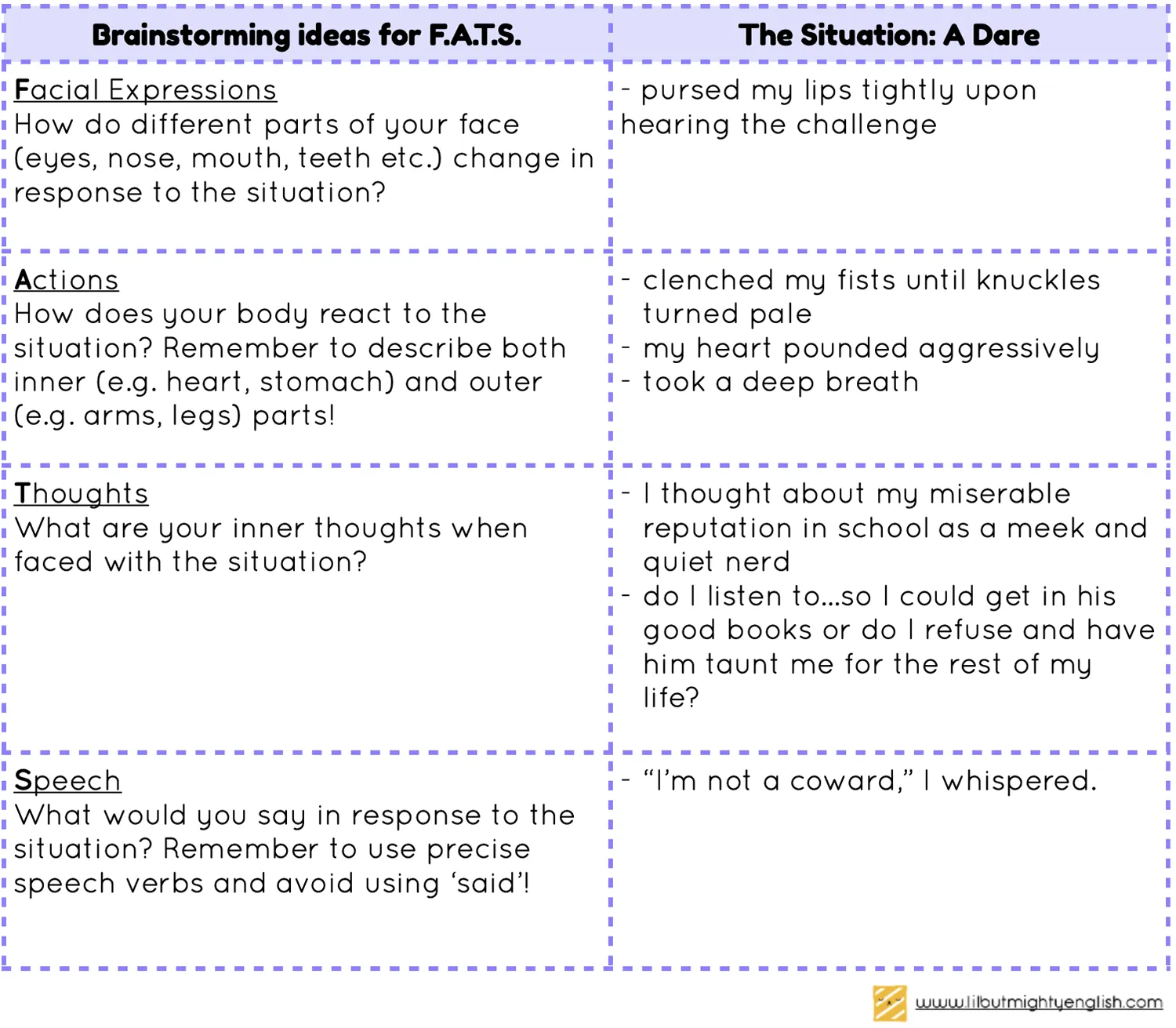
The final step is to put everything together. The paragraph should look something like this:

Take note of how the final choice made by the writer relates closely to the question, i.e. since the first part of the question is about doing something to impress someone, the writer makes the final decision to steal the book in order to impress Ben the bully. Remember this when you are crafting your dilemma for the Personal Recount that you are writing.
Now, it’s your turn to try! Using F.A.T.S. , think of a dilemma you would have for the following topic, and how you can apply F.A.T.S. to develop it:
Write about a time when you disappointed someone close to you.
Remember to follow the steps I have outlined above to help you get started. First, think of a dilemma that is related to the question. Use the 5W1H questions to help you brainstorm some ideas, for instance: Who was the person that I disappointed? What action did I do that disappointed this person? When did this take place?
Here is an example of a possible response:
While sitting for my end-of-year examination, I notice my best friend cheating and looking at answers from a slip of paper under the table. Do I tell our teacher about her actions and risk disappointing my beloved friend, or do I keep quiet and carry the burden of ignoring her dishonest actions?
Next, develop the dilemma using F.A.T.S. by using the questions below to help you. Remember to jot down your ideas next to the questions:
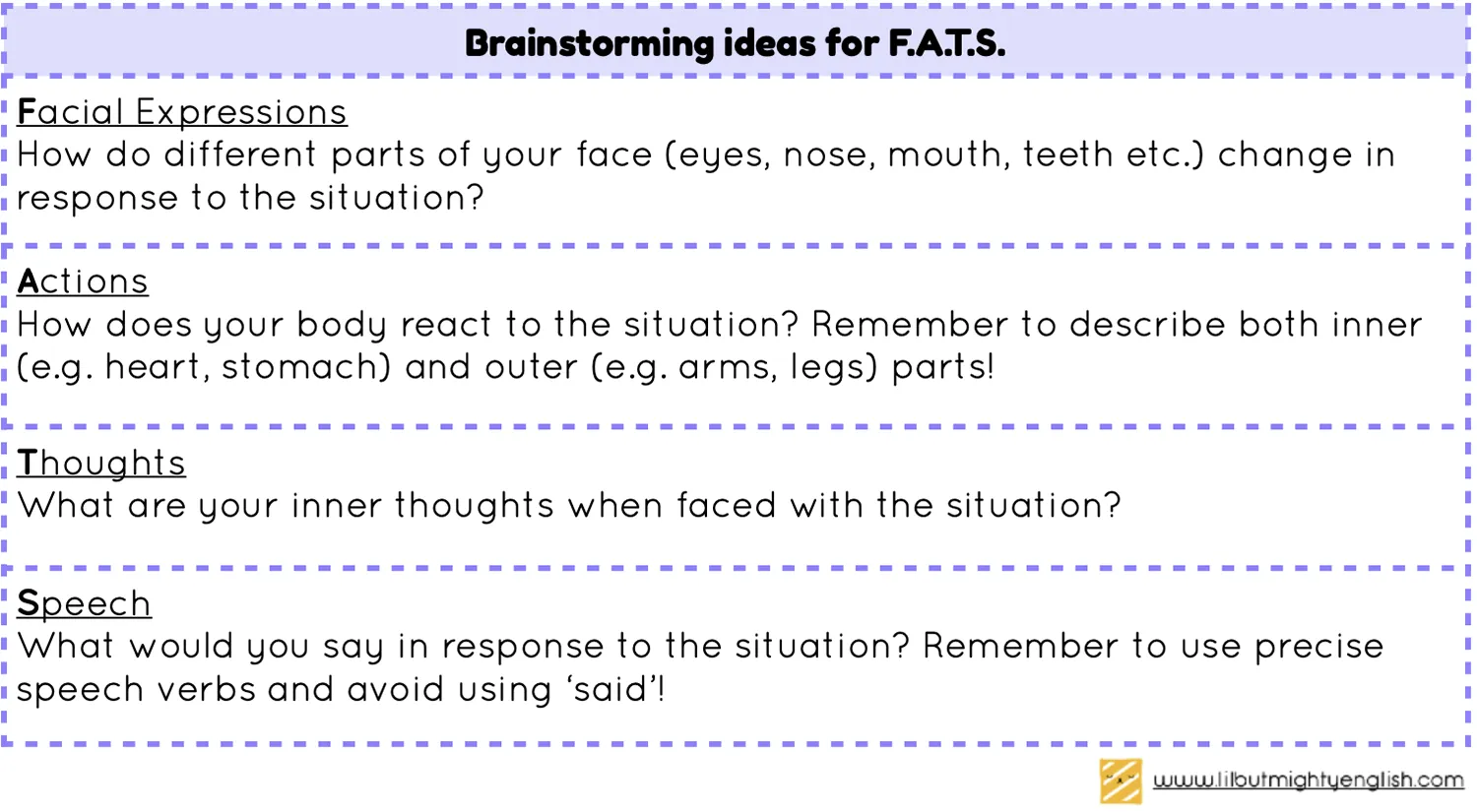
Putting everything together, you should have written something like this:
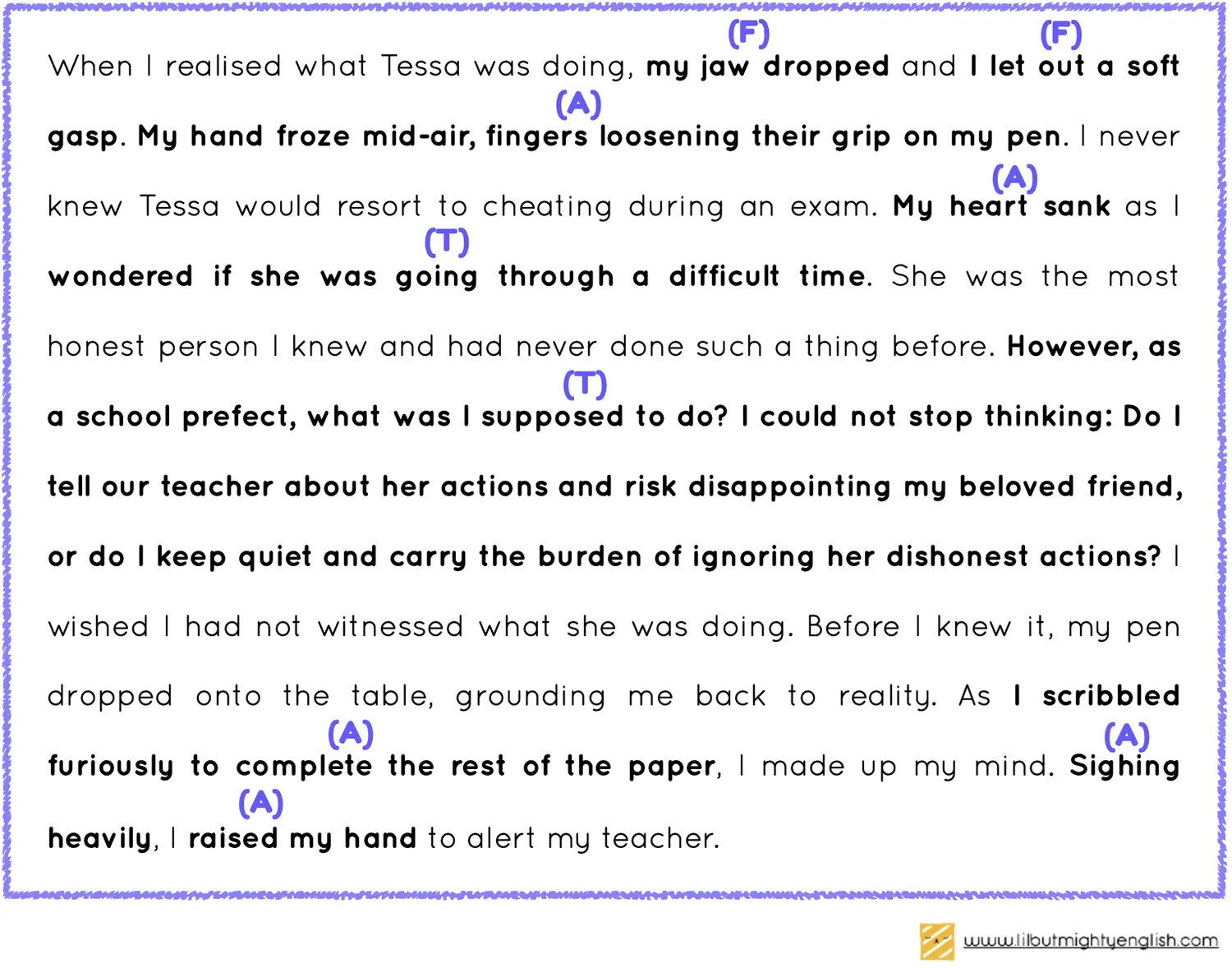
Again, remember to show how the final choice made is closely linked to the question, i.e. the writer makes the final decision to inform the teacher about her friend’s dishonest act and in this way, disappoints her friend who would have expected the writer to cover for her.
Also, notice how S (Speech) is not present in the dilemma. This is because the situation the writer finds herself in (taking an exam) does not lend itself to the use of speech. Hence, whilst using F.A.T.S. will help you to develop your dilemma, you should also take heed to ensure that its usage fits the situation in the recount. If you find yourself being unable to use any part of F.A.T.S. , you can try to describe more of the other parts, like how in the example above I have included more descriptions for A (Actions) and T (Thoughts), to ensure that the dilemma is still well-elaborated.
I hope you give this practice a try, and remember to explore using a dilemma in your Personal Recounts if it is relevant to the topic. Don’t forget to apply the F.A.T.S. technique to develop your dilemmas as well. Happy writing!

ENGLISH COMPOSITION PLAN? WHAT’S THAT?
Good writers plan. They think through what they want to write before they actually write.
Before writing a story, some good writers may write their plans down or draw a mind map.
Sometimes, they SEEM like they are not planning but actually, they already know what is necessary for a good English Composition (due to numerous practice!) and have formed a mental plan in their minds.
It all starts with a plan. With a good plan, half the battle is won before you even start writing.
- Find Out More

In her time teaching, she has incorporated elements of drama into her classes to engage her lower primary students. She tries her best to get to know all of her students and is always keen to find out each of their interests and hobbies. She believes that each student has personalised needs, and aims to make lessons fun and helpful for all of her students.
Have something to share? Drop us a comment below!
Leave a reply.
You must be logged in to post a comment.
Other related posts

Creative Writing | 3 Easy Steps to Write Your Own Haiku!
- Creative Writing & Compo
Verbs: More than Just Action Words! | Part 3: Changes in Verb Forms
Ketchup on english – is, are, was and were.
- Grammar , Lower Primary
Audience In Visual Text | Visual Text Comprehension
- Visual Text Comprehension

Exploring Points of View (POV) in Composition Writing
Metaphors for | part ii – implied metaphors.


10 Beautiful Vivid Verbs to Boost Your Writing and Oral! | Primary School English
- Creative Writing & Compo , Oral
Metaphors For? | Part I – An Introduction to Metaphors

3 Family-Friendly Shows on Netflix (Educational & Entertaining)!
- English in the real world
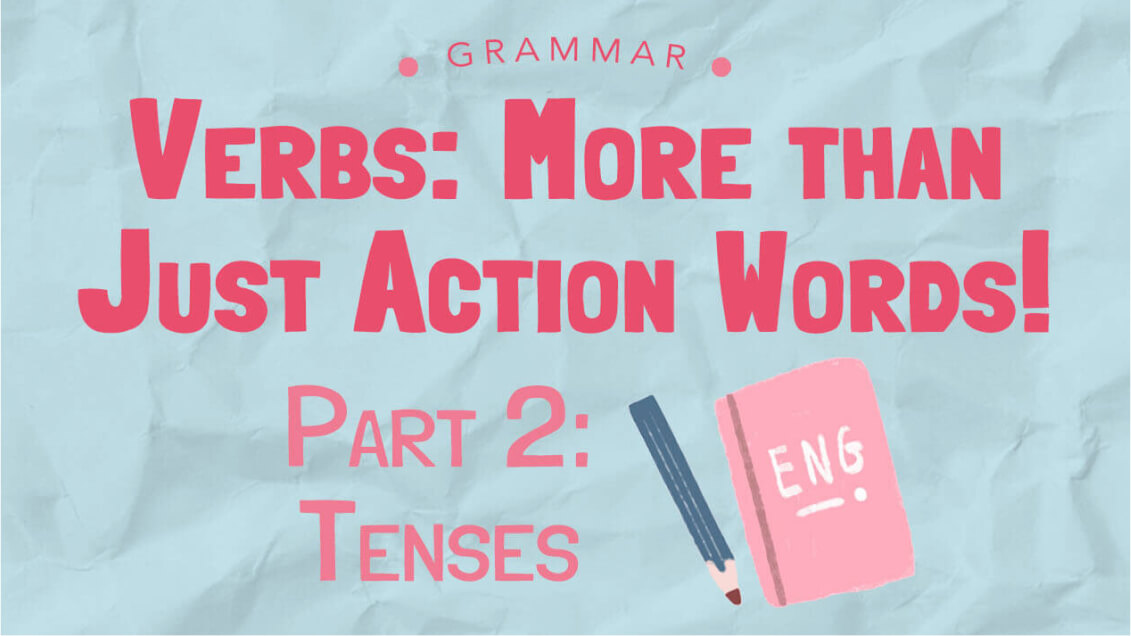
Verbs: More than Just Action Words! | Part 2: Tenses
2021 father’s day contest winners.
- Company News
Verbs: More than Just Action Words! | Part 1: Subject-Verb Agreement

10 Beautiful Words You Can Use in Narrative / Descriptive Writing | Secondary School
- Secondary School English

Ways To Create A Well-Rounded Character | Creative Writing
Understanding purpose-related questions in visual text comprehension.

How Playing Video Games Can Improve Our English (With Practical Tips for Parents!)

Primary School Composition | Onomatopoeia – What’s That?
2021 mother’s day contest winners + our founder’s journey (mother’s day special).
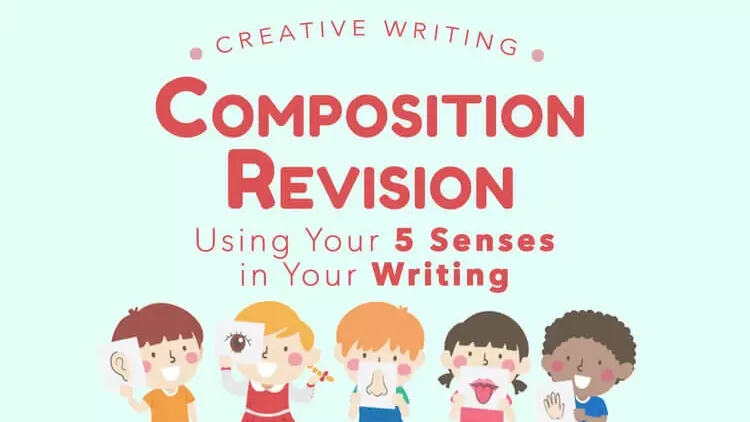
Composition Revision: Using Your 5 Senses in Your Writing
How to create a dynamic piece of writing using idioms, ketchup on english – subject-verb agreement, punctuation marks: colon vs. semicolon.

4 steps to Create Suspense

Earth Hour – Oral Topic
That simile though 2 | using stronger similes.

3 Tips for English Comprehension (Open-Ended)
- Comprehension

PSLE ORAL | Compiled Prelim 2021 Oral Topics + Questions!
- Free Downloads , Oral
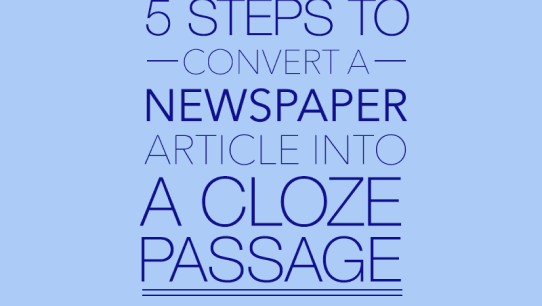
5 Steps to Convert a Newspaper Article into a Cloze Passage
- Cloze Passage and Editing , Free Downloads , Primary School English

PSLE English | Oral Conversation: Free SG50 Sample Practice + Model Answers
- Free Downloads , Oral , Primary School English

PSLE English | Oral Conversation: Filling your Story with Details Easily + Free Revision Cards
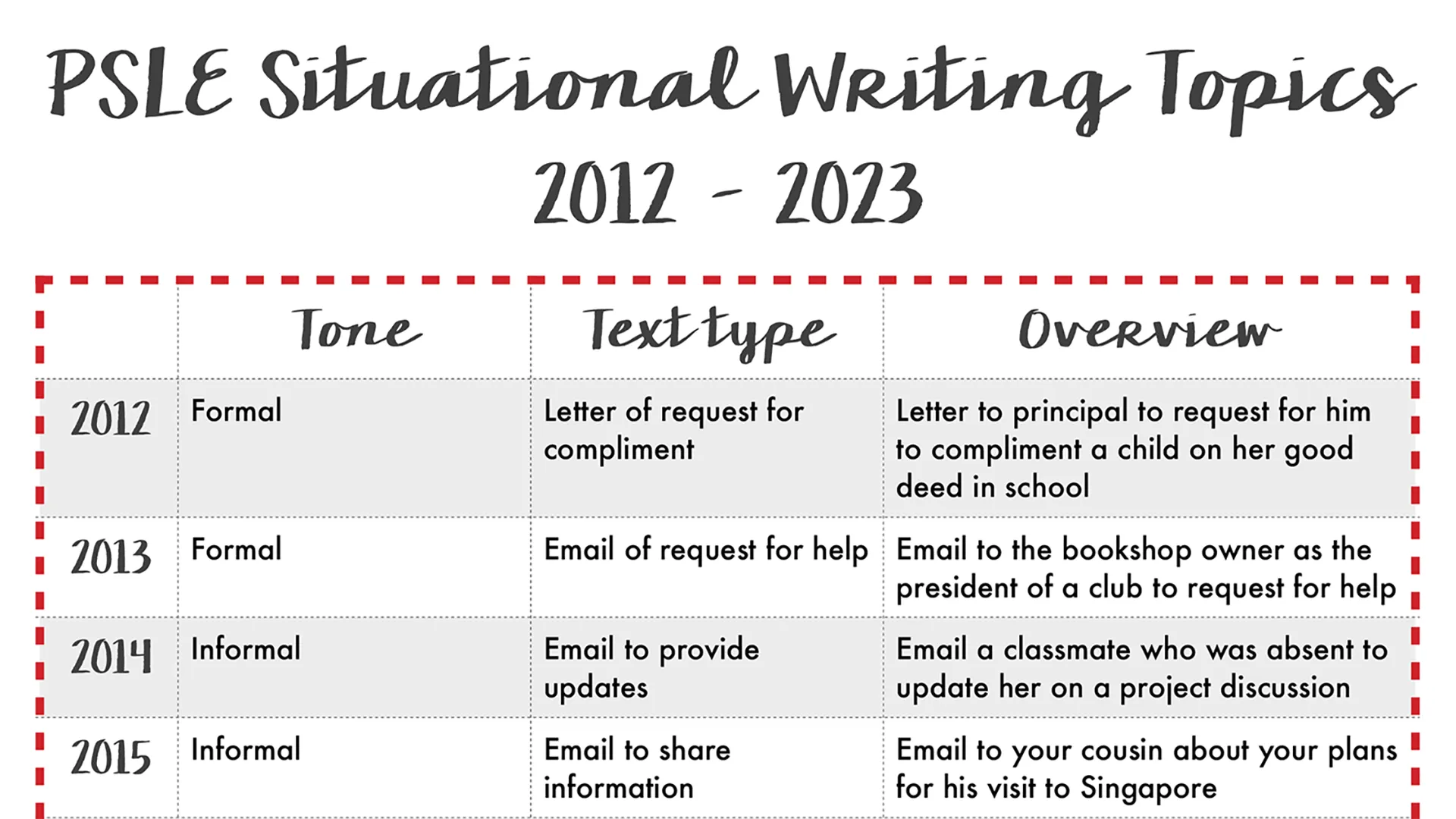
PSLE English | Situational Writing: Q&A + Formal vs Informal Writing Comparison Chart
- Free Downloads , Primary School English , Situational Writing

PSLE English Tips | Oral: Stimulus-Based Conversation Checklist

A Little Encouragement | DIY Motivational Bookmark (Easy to personalise too!)
- English in the real world , Free Downloads , Reading

Situational Writing: Step-by-Step Guide + Free Revision Card

I Love Reading | 5 Ways to Motivate Reluctant Readers
- English in the real world , Free Downloads

PSLE English | Printable Ultimate Grammar & Synthesis Summary
- Free Downloads , Grammar , Sentence Synthesis

How Well Do You Know Your Past Participles?
- Free Downloads , Grammar

Primary Composition Writing | Starting Sentences with Introductory Clauses
- Creative Writing & Compo , Free Downloads

The Sentence Train | Lower Primary English

PSLE English Tips | Oral: Reading Checklist

Language of COVID | 10 Words Added to the Dictionary
- English in the real world , Vocabulary

Using Personification to Show, Not Tell!
- Creative Writing & Compo , Primary School English
Expressing Character Feelings Too! | Using Show-Not-Tell (Part 2)
How to choose a book to read: 8 ways.

How to Dress Up A Boring Paragraph | Creative Writing
Ketchup on english – halloween special: prepositions of time.
- Lower Primary
Ketchup on English! – Verbs Are Not Just Action Words!

Expressing Character Feelings | Using Show-Not-Tell
Which picture should i use | choosing the best picture to use for composition.

Oral: Reading Passage | Long Vowels – Have You Been Reading Your Vowels Correctly?
Like what you are reading.
Subscribe now to receive news and tips hot off the press!
The greatest joy in giving small group tuition is a teacher’s ability to create greater impact in the children that have been entrusted to her care.
Our Programmes
- Primary English
- Secondary English
- Self-Paced Online Courses
- School Clients
- Copyright Terms & Conditions
- Personal Data Protection Policy
- Registration Terms & Conditions
- Contest Terms & Conditions
Lil’ but Mighty Clementi Block 432 Clementi Avenue 3, #01-282, Singapore 120432
Lil’ but Mighty Bukit Timah 170 Upper Bukit Timah Road, #B2-02 Bukit Timah Shopping Centre, Singapore 588179
Lil’ but Mighty Hougang Block 211 Hougang Street 21, #01-305 (Back entrance), Singapore 530211
Lil’ but Mighty Novena 1 Goldhill Plaza, #02-25, Singapore 308899
Lil’ but Mighty Marine Parade 1 Marine Parade, #04-05 Parkway Centre, Singapore 449408
Lil’ but Mighty Tampines 3 Tampines Central 1, #06-03 Tampines Plaza 1, Singapore 529540

- SUGGESTED TOPICS
- The Magazine
- Newsletters
- Managing Yourself
- Managing Teams
- Work-life Balance
- The Big Idea
- Data & Visuals
- Reading Lists
- Case Selections
- HBR Learning
- Topic Feeds
- Account Settings
- Email Preferences
How to Write a Personal Essay for Your College Application

What does it take to land in the “accept” (instead of “reject”) pile?
How can you write an essay that helps advance you in the eyes of the admissions officers and makes a real impression? Here are some tips to get you started.
- Start early. Do not leave it until the last minute. Give yourself time when you don’t have other homework or extracurriculars hanging over your head to work on the essay.
- Keep the focus narrow. Your essay does not have to cover a massive, earth-shattering event. Some people in their teens haven’t experienced a major life event. Some people have. Either way, it’s okay.
- Be yourself. Whether writing about a painful experience or a more simple experience, use the narrative to be vulnerable and honest about who you are. Use words you would normally use. Trust your voice and the fact that your story is interesting enough in that no one else has lived it.
- Be creative. “Show, don’t tell,” and that applies here — to an extent. The best essays typically do both. You can help your reader see and feel what you are describing by using some figurative language throughout your piece.
- Make a point. As you finish your final body paragraphs ask yourself “So what?” This will help you hone in on how to end your essay in a way that elevates it into a story about an insight or discovery you made about yourself, rather than just being about an experience you had.
Where your work meets your life. See more from Ascend here .
We’ve all heard about the dreaded “college essay,” the bane of every high school senior’s existence. This daunting element of the college application is something that can create angst for even the most accomplished students.
- AA Amy Allen is a writer, educator, and lifelong learner. Her freelance writing business, All of the Write Words , focuses on providing high school students with one-on-one feedback to guide them through the college application process and with crafting a thoughtful personal essay. A dedicated poet, Amy’s work has also been published in several journals including Pine Row Press , Months to Years, and Atlanta Review .
Partner Center
What are your chances of acceptance?
Calculate for all schools, your chance of acceptance.
Your chancing factors
Extracurriculars.
How to Write the “Overcoming Challenges” Essay + Examples
What’s covered:.
- What is the Overcoming Challenges Essay?
- Real Overcoming Challenges Essay Prompts
- How to Choose a Topic
- Writing Tips
Overcoming Challenges Essay Examples
- Where to Get Your Essay Edited
While any college essay can be intimidating, the Overcoming Challenges prompt often worries students the most. Those students who’ve been lucky enough not to experience trauma tend to assume they have nothing worth saying. On the other hand, students who’ve overcome larger obstacles may be hesitant to talk about them.
Regardless of your particular circumstances, there are steps you can take to make the essay writing process simpler. Here are our top tips for writing the overcoming challenges essay successfully.
What is the “Overcoming Challenges” Essay?
The overcoming challenges prompt shows up frequently in both main application essays (like the Common App) and supplemental essays. Because supplemental essays allow students to provide schools with additional information, applicants should be sure that the subject matter they choose to write about differs from what’s in their main essay.
Students often assume the overcoming challenges essay requires them to detail past traumas. While you can certainly write about an experience that’s had a profound effect on your life, it’s important to remember that colleges aren’t evaluating students based on the seriousness of the obstacle they overcame.
On the contrary, the goal of this essay is to show admissions officers that you have the intelligence and fortitude to handle any challenges that come your way. After all, college serves as an introduction to adult life, and schools want to know that the students they admit are up to the task.
Real “Overcoming Challenges” Essay Prompts
To help you understand what the “Overcoming Challenges” essay looks like, here are a couple sample prompts.
Currently, the Common Application asks students to answer the following prompt in 650 words or less:
“The lessons we take from obstacles we encounter can be fundamental to later success. Recount a time when you faced a challenge, setback, or failure. How did it affect you, and what did you learn from the experience?”
For the past several years, MIT has prompted students to write 200 to 250 words on the following:
“Tell us about the most significant challenge you’ve faced or something important that didn’t go according to plan. How did you manage the situation?”
In both cases, the prompts explicitly ask for your response to the challenge. The event itself isn’t as important as how it pushed you to grow.
How to Choose a Topic for an Essay on Overcoming Challenges
When it comes to finding the best topic for your overcoming challenges essays, there’s no right answer. The word “challenge” is ambiguous and could be used to reference a wide range of situations from prevailing over a bully to getting over your lifelong stage fright to appear in a school musical. Here are some suggestions to keep in mind when selecting an essay subject.
1. Avoid trivial or common topics
While there aren’t many hard-and-fast rules for choosing an essay topic, students should avoid overdone topics.
These include:
- Working hard in a challenging class
- Overcoming a sports injury
- Moving schools or immigrating to the US
- Tragedy (divorce, death, abuse)
Admissions officers have read numerous essays on the subject, so it’s harder for you to stand out (see our full list of cliché college essay topics to avoid ). If events like these were truly formative to you, you can still choose to write about them, but you’ll need to be as personal as possible.
It’s also ideal if you have a less traditional storyline for a cliché topic; for example, if your sports injury led you to discover a new passion, that would be a more unique story than detailing how you overcame your injury and got back in the game.
Similarly, students may not want to write about an obstacle that admissions committees could perceive as low stakes, such as getting a B on a test, or getting into a small fight with a friend. The goal of this essay is to illustrate how you respond to adversity, so the topic you pick should’ve been at least impactful on your personal growth.
2. Pick challenges that demonstrate qualities you want to highlight
Students often mistakenly assume they need to have experienced exceptional circumstances like poverty, an abusive parent, or cancer to write a good essay. The truth is that the best topics will allow you to highlight specific personal qualities and share more about who you are. The essay should be less about the challenge itself, and more about how you responded to it.
Ask yourself what personality traits you want to emphasize, and see what’s missing in your application. Maybe you want to highlight your adaptability, for example, but that isn’t clearly expressed in your application. In this case, you might write about a challenge that put your adaptability to the test, or shaped you to become more adaptable.
Here are some examples of good topics we’ve seen over the years:
- Not having a coach for a sports team and becoming one yourself
- Helping a parent through a serious health issue
- Trying to get the school track dedicated to a coach
- Having to switch your Model UN position last-minute
Tips for Writing an Essay About Overcoming Challenges
Once you’ve selected a topic for your essays, it’s time to sit down and write. For best results, make sure your essay focuses on your efforts to tackle an obstacle rather than the problem itself. Additionally, you could avoid essay writing pitfalls by doing the following:
1. Choose an original essay structure
If you want your overcoming challenges essay to attract attention, aim to break away from more traditional structures. Most of these essays start by describing an unsuccessful attempt at a goal and then explain the steps the writer took to master the challenge.
You can stand out by choosing a challenge you’re still working on overcoming, or focus on a mental or emotional challenge that spans multiple activities or events. For example, you might discuss your fear of public speaking and how that impacted your ability to coach your brother’s Little League team and run for Student Council.
You can also choose a challenge that can be narrated in the moment, such as being put on the spot to teach a yoga class. These challenges can make particularly engaging essays, as you get to experience the writer’s thoughts and emotions as they unfold.
Keep in mind that you don’t necessarily need to have succeeded in your goal for this essay. Maybe you ran for an election and lost, or maybe you proposed a measure to the school board that wasn’t passed. It’s still possible to write a strong essay about topics like these as long as you focus on your personal growth. In fact, these may make for even stronger essays since they are more unconventional topics.
2. Focus on the internal
When writing about past experiences, you may be tempted to spend too much time describing specific people and events. With an Overcoming Challenges essay though, the goal is to focus on your thoughts and feelings.
For example, rather than detail all the steps you took to become a better public speaker, use the majority of your essay to describe your mental state as you embarked on the journey to achieving your goals. Were you excited, scared, anxious, or hopeful? Don’t be afraid to let the reader in on your innermost emotions and thoughts during this process.
3. Share what you learned
An Overcoming Challenges essay should leave the reader with a clear understanding of what you learned on your journey, be it physical, mental, or emotional. There’s no need to explicitly say “this experience taught me X,” but your essay should at least implicitly share any lessons you learned. This can be done through your actions and in-the-moment reflections. Remember that the goal is to show admissions committees why your experiences make you a great candidate for admission.
Was I no longer the beloved daughter of nature, whisperer of trees? Knee-high rubber boots, camouflage, bug spray—I wore the g arb and perfume of a proud wild woman, yet there I was, hunched over the pathetic pile of stubborn sticks, utterly stumped, on the verge of tears. As a child, I had considered myself a kind of rustic princess, a cradler of spiders and centipedes, who was serenaded by mourning doves and chickadees, who could glide through tick-infested meadows and emerge Lyme-free. I knew the cracks of the earth like the scars on my own rough palms. Yet here I was, ten years later, incapable of performing the most fundamental outdoor task: I could not, for the life of me, start a fire.
Furiously I rubbed the twigs together—rubbed and rubbed until shreds of skin flaked from my fingers. No smoke. The twigs were too young, too sticky-green; I tossed them away with a shower of curses, and began tearing through the underbrush in search of a more flammable collection. My efforts were fruitless. Livid, I bit a rejected twig, determined to prove that the forest had spurned me, offering only young, wet bones that would never burn. But the wood cracked like carrots between my teeth—old, brittle, and bitter. Roaring and nursing my aching palms, I retreated to the tent, where I sulked and awaited the jeers of my family.
Rattling their empty worm cans and reeking of fat fish, my brother and cousins swaggered into the campsite. Immediately, they noticed the minor stick massacre by the fire pit and called to me, their deep voices already sharp with contempt.
“Where’s the fire, Princess Clara?” they taunted. “Having some trouble?” They prodded me with the ends of the chewed branches and, with a few effortless scrapes of wood on rock, sparked a red and roaring flame. My face burned long after I left the fire pit. The camp stank of salmon and shame.
In the tent, I pondered my failure. Was I so dainty? Was I that incapable? I thought of my hands, how calloused and capable they had been, how tender and smooth they had become. It had been years since I’d kneaded mud between my fingers; instead of scaling a white pine, I’d practiced scales on my piano, my hands softening into those of a musician—fleshy and sensitive. And I’d gotten glasses, having grown horrifically nearsighted; long nights of dim lighting and thick books had done this. I couldn’t remember the last time I had lain down on a hill, barefaced, and seen the stars without having to squint. Crawling along the edge of the tent, a spider confirmed my transformation—he disgusted me, and I felt an overwhelming urge to squash him.
Yet, I realized I hadn’t really changed—I had only shifted perspective. I still eagerly explored new worlds, but through poems and prose rather than pastures and puddles. I’d grown to prefer the boom of a bass over that of a bullfrog, learned to coax a different kind of fire from wood, having developed a burn for writing rhymes and scrawling hypotheses.
That night, I stayed up late with my journal and wrote about the spider I had decided not to kill. I had tolerated him just barely, only shrieking when he jumped—it helped to watch him decorate the corners of the tent with his delicate webs, knowing that he couldn’t start fires, either. When the night grew cold and the embers died, my words still smoked—my hands burned from all that scrawling—and even when I fell asleep, the ideas kept sparking—I was on fire, always on fire.
This essay is an excellent example because the writer turns an everyday challenge—starting a fire—into an exploration of her identity. The writer was once “a kind of rustic princess, a cradler of spiders and centipedes,” but has since traded her love of the outdoors for a love of music, writing, and reading.
The story begins in media res , or in the middle of the action, allowing readers to feel as if we’re there with the writer. One of the essay’s biggest strengths is its use of imagery. We can easily visualize the writer’s childhood and the present day. For instance, she states that she “rubbed and rubbed [the twigs] until shreds of skin flaked from my fingers.”
The writing has an extremely literary quality, particularly with its wordplay. The writer reappropriates words and meanings, and even appeals to the senses: “My face burned long after I left the fire pit. The camp stank of salmon and shame.” She later uses a parallelism to cleverly juxtapose her changed interests: “instead of scaling a white pine, I’d practiced scales on my piano.”
One of the essay’s main areas of improvement is its overemphasis on the “story” and lack of emphasis on the reflection. The second to last paragraph about changing perspective is crucial to the essay, as it ties the anecdote to larger lessons in the writer’s life. She states that she hasn’t changed, but has only shifted perspective. Yet, we don’t get a good sense of where this realization comes from and how it impacts her life going forward.
The end of the essay offers a satisfying return to the fire imagery, and highlights the writer’s passion—the one thing that has remained constant in her life.
“Getting beat is one thing – it’s part of competing – but I want no part in losing.” Coach Rob Stark’s motto never fails to remind me of his encouragement on early-morning bus rides to track meets around the state. I’ve always appreciated the phrase, but an experience last June helped me understand its more profound, universal meaning.
Stark, as we affectionately call him, has coached track at my high school for 25 years. His care, dedication, and emphasis on developing good character has left an enduring impact on me and hundreds of other students. Not only did he help me discover my talent and love for running, but he also taught me the importance of commitment and discipline and to approach every endeavor with the passion and intensity that I bring to running. When I learned a neighboring high school had dedicated their track to a longtime coach, I felt that Stark deserved similar honors.
Our school district’s board of education indicated they would only dedicate our track to Stark if I could demonstrate that he was extraordinary. I took charge and mobilized my teammates to distribute petitions, reach out to alumni, and compile statistics on the many team and individual champions Stark had coached over the years. We received astounding support, collecting almost 3,000 signatures and pages of endorsements from across the community. With help from my teammates, I presented this evidence to the board.
They didn’t bite.
Most members argued that dedicating the track was a low priority. Knowing that we had to act quickly to convince them of its importance, I called a team meeting where we drafted a rebuttal for the next board meeting. To my surprise, they chose me to deliver it. I was far from the best public speaker in the group, and I felt nervous about going before the unsympathetic board again. However, at that second meeting, I discovered that I enjoy articulating and arguing for something that I’m passionate about.
Public speaking resembles a cross country race. Walking to the starting line, you have to trust your training and quell your last minute doubts. When the gun fires, you can’t think too hard about anything; your performance has to be instinctual, natural, even relaxed. At the next board meeting, the podium was my starting line. As I walked up to it, familiar butterflies fluttered in my stomach. Instead of the track stretching out in front of me, I faced the vast audience of teachers, board members, and my teammates. I felt my adrenaline build, and reassured myself: I’ve put in the work, my argument is powerful and sound. As the board president told me to introduce myself, I heard, “runners set” in the back of my mind. She finished speaking, and Bang! The brief silence was the gunshot for me to begin.
The next few minutes blurred together, but when the dust settled, I knew from the board members’ expressions and the audience’s thunderous approval that I had run quite a race. Unfortunately, it wasn’t enough; the board voted down our proposal. I was disappointed, but proud of myself, my team, and our collaboration off the track. We stood up for a cause we believed in, and I overcame my worries about being a leader. Although I discovered that changing the status quo through an elected body can be a painstakingly difficult process and requires perseverance, I learned that I enjoy the challenges this effort offers. Last month, one of the school board members joked that I had become a “regular” – I now often show up to meetings to advocate for a variety of causes, including better environmental practices in cafeterias and safer equipment for athletes.
Just as Stark taught me, I worked passionately to achieve my goal. I may have been beaten when I appealed to the board, but I certainly didn’t lose, and that would have made Stark proud.
While the writer didn’t succeed in getting the track dedicated to Coach Stark, their essay is certainly successful in showing their willingness to push themselves and take initiative.
The essay opens with a quote from Coach Stark that later comes full circle at the end of the essay. We learn about Stark’s impact and the motivation for trying to get the track dedicated to him.
One of the biggest areas of improvement in the intro, however, is how the essay tells us Stark’s impact rather than showing us: His care, dedication, and emphasis on developing good character has left an enduring impact on me and hundreds of other students. Not only did he help me discover my talent and love for running, but he also taught me the importance of commitment and discipline and to approach every endeavor with the passion and intensity that I bring to running.
The writer could’ve helped us feel a stronger emotional connection to Stark if they had included examples of Stark’s qualities, rather than explicitly stating them. For example, they could’ve written something like: Stark was the kind of person who would give you gas money if you told him your parents couldn’t afford to pick you up from practice. And he actually did that—several times. At track meets, alumni regularly would come talk to him and tell him how he’d changed their lives. Before Stark, I was ambivalent about running and was on the JV team, but his encouragement motivated me to run longer and harder and eventually make varsity. Because of him, I approach every endeavor with the passion and intensity that I bring to running.
The essay goes on to explain how the writer overcame their apprehension of public speaking, and likens the process of submitting an appeal to the school board to running a race. This metaphor makes the writing more engaging and allows us to feel the student’s emotions.
While the student didn’t ultimately succeed in getting the track dedicated, we learn about their resilience and initiative: I now often show up to meetings to advocate for a variety of causes, including better environmental practices in cafeterias and safer equipment for athletes.
Overall, this essay is well-done. It demonstrates growth despite failing to meet a goal, which is a unique essay structure. The running metaphor and full-circle intro/ending also elevate the writing in this essay.
Where to Get Your Overcoming Challenges Essay Edited
The Overcoming Challenges essay is one of the trickier supplemental prompts, so it’s important to get feedback on your drafts. That’s why we created our free Peer Essay Review tool , where you can get a free review of your essay from another student. You can also improve your own writing skills by reviewing other students’ essays.
If you want a college admissions expert to review your essay, advisors on CollegeVine have helped students refine their writing and submit successful applications to top schools. Find the right advisor for you to improve your chances of getting into your dream school!
Related CollegeVine Blog Posts

+65 87491430

THE WRITE TRIBE
- Aug 26, 2023
Personal recount Reflective model essay Secondary
Personal recount/reflective model essay secondary, topic: write about a time when you did something to impress someone which you later regretted.
This is a common topic for secondary school students. Below you will find a Personal recount/Reflective model essay sample for secondary school students. You can use this as inspiration for your writing. Also, do not forget to download the FREE SAMPLE to our O'Level & Secondary Essay Writing Cheat Sheet.

I can never forgive myself for this. Till today I regret this and the memory haunts me. I was in Primary 5. It was the first day of school when Deaven waltzed into class. Her hair was unkempt, the buttons from her uniform were missing and nobody liked her. Despite that, out of the kindness of my heart, I was drawn to her. She was lonely and often sat alone in the canteen. Soon, I would join her and a friendship blossomed between us.
Fast forward a few months later, things did not improve with Deaven. The bullying got out of hand, Deaven was often the last one to be picked when it came to group projects. When she was finally 'forced' to join a group, she would be greeted with looks of disdain. Despite all that happened, I chose to hang out with Deaven until late August.
I was contesting for class president and the support of my fellow classmates was important. I was pretty popular and doing well. However, one late Friday afternoon, things changed. As I was grooming myself in the bathroom, I was approached by a group of 'popular' girls from my class.
"Are you Deaven's friend?" Pricilia, the 'ringmaster' of the group inquired.
"Yes!" I replied.
"Ew! I thought you were cool. If you are friends with her, I guess I'll just have to tell everyone not to vote for you!" Priscillia sneered at me. Soon after, they left. I did not think much about it. However, what happened the following Monday made me reconsider my friendship with Deaven.
The following Monday, I was given the cold shoulder by almost everyone in class. Whatever Priscillia was doing was succeeding. I was not popular and I witnessed my votes dwindling. Feeling afraid, I would not be well-liked by everyone, I did something that I would regret.
During recess, when Deaven approached to sit beside me. I did something awful. Before, she could sit down, I pulled her chair away and Deaven crashed onto the floor. While everyone started laughing, I joined in the laughter. To add fuel to the fire, I pretended to drop my soda on her by 'accident.' Soon, the canteen was filled with hoots of laughter but Deaven's face cascaded with tears. Eventually, I won the favour of my classmates back. I became the class president. I never really engaged with Deaven again. Months later, she left for another school and I never saw her again. Though I became class president, my conscience pricked me. I can never forget the look of betrayal on her face when I pulled the chair from her. Years later, I am combing through different social media platforms to get a glimpse of Deaven so I can just tell her how much I regret hurting her. This is one regret I may have to carry for the rest of my life.
Recent Posts
A good deed model composition primary example
An Encouraging moment / An Encouragement / Encouraging someone Model Composition Sample
A kind act composition for primary school
Comentários

IMAGES
VIDEO
COMMENTS
When used in the context of writing a recount, the 5-paragraph essay will look something like this: The Orientation: Paragraph 1. In the introductory paragraph, the student will establish the setting and introduce the characters and the topic of the recount. The Events: Paragraphs 2-4.
If these instructions are not included and you aren't sure about how long the piece must be, consider asking your teacher directly. 2. Understand the purpose. Ask yourself what you hope to achieve by writing your recount. You need to accurately portray a real event you were personally involved in.
While writing an essay, you should always keep the following points in mind: Use of first-person pronouns: I, me, myself, mine, my, we, us, ourselves, ours, our. Use of simple past tense. Use of connectors. Connectors are words such as however, furthermore, then etc. and are used to give flow.
1. For a personal recount essay, you really need to do STORYTELLING. The story must capture the imagination of the reader. I will share some tips below about how you can do this. 2. You need to think out of the box. Please reject those hackneyed plots. Examiners have seen too many of those. If you do want to use a common idea, make sure that ...
Step 4: Write an Engaging Introduction. Your introduction should hook the reader and prompt them to continue reading. Begin with a sentence that sparks curiosity or sets the scene for your recount text. Briefly, provide context about the event or experience - when it happened, who was involved, and any other relevant details.
However, like any other type of writing, it comes with guidelines. 1. Write Your Personal Narrative as a Story. As a story, it must include an introduction, characters, plot, setting, climax, anti-climax (if any), and conclusion. Another way to approach it is by structuring it with an introduction, body, and conclusion.
Let's see how we can apply F.A.T.S. to develop a dilemma according to the following essay question: Write about a time when you did something just to impress someone which you later regretted. (O Level 2020 Paper 1 Section C) First, think of a dilemma you would have that is relevant to the topic.
A completely guide on how to write a recount including examples, linguistic features is a recount text, schematic structure regarding recount resources additionally hint. A complete guide the how to write a tell including examples, linguistic features of a recount text, schematic structure in recount resources and tips.
6. Use a tone that reflects your message. A tone can be affectionate, sarcastic, playful, or self-deprecating. Don't exaggerate the tone, unless it's for humorous effect, and then make sure it's obvious. You don't want to risk alienating your readers by being overly political, preachy, crude, gross, or intolerant.
Here's a recap of the contents of this article, which also serves as a way to create a mind map: 1. Identify the topic you will be writing on. 2. Note down any ideas that are related to the topic and if you want to, try drawing a diagram to link together any topics, theories, and ideas. 3.
Stuck on your essay? Browse essays about Personal Recount and find inspiration. Learn by example and become a better writer with Kibin's suite of essay help services. > Personal Recount Essay Examples. 119 total results. staff pick ... Essay Writing Blog; Follow. Facebook X (Twitter)
Here are some tips to get you started. Start early. Do not leave it until the last minute. Give yourself time when you don't have other homework or extracurriculars hanging over your head to ...
Strategy 1: Open with a concrete scene. An effective way to catch the reader's attention is to set up a scene that illustrates something about your character and interests. If you're stuck, try thinking about: A personal experience that changed your perspective. A story from your family's history.
1. Avoid trivial or common topics. While there aren't many hard-and-fast rules for choosing an essay topic, students should avoid overdone topics. These include: Working hard in a challenging class. Overcoming a sports injury. Moving schools or immigrating to the US. Tragedy (divorce, death, abuse)
Include your hook, state your thesis, and form an emotional connection with the reader. Set your audience up for what your piece will be about and give them something to look forward to. 3. Fill your body paragraphs. Use sensory details about the sequence of events surrounding your thesis to guide the reader through your personal essay. Build ...
In a great personal statement, we should be able to get a sense of what fulfills, motivates, or excites the author. These can be things like humor, beauty, community, and autonomy, just to name a few. So when you read back through your essay, you should be able to detect at least 4-5 different values throughout.
Focus on a specific moment, and describe the scene using your five senses. Mention objects that have special significance to you. Instead of following a common story arc, include a surprising twist or insight. Your unique voice can shed new perspective on a common human experience while also revealing your personality.
A finish guide on instructions at write an recount including samples, linguistic features of a recount text, schematic structure from recount tools plus tips. A full guide on how to writes an recount including examples, speaking features of adenine recount text, diagrams structure of report resources the tips.
Personal recount/Reflective model essay SecondaryTopic: Write about a time when you did something to impress someone which you later regrettedThis is a common topic for secondary school students. Below you will find a Personal recount/Reflective model essay sample for secondary school students. You can use this as inspiration for your writing.